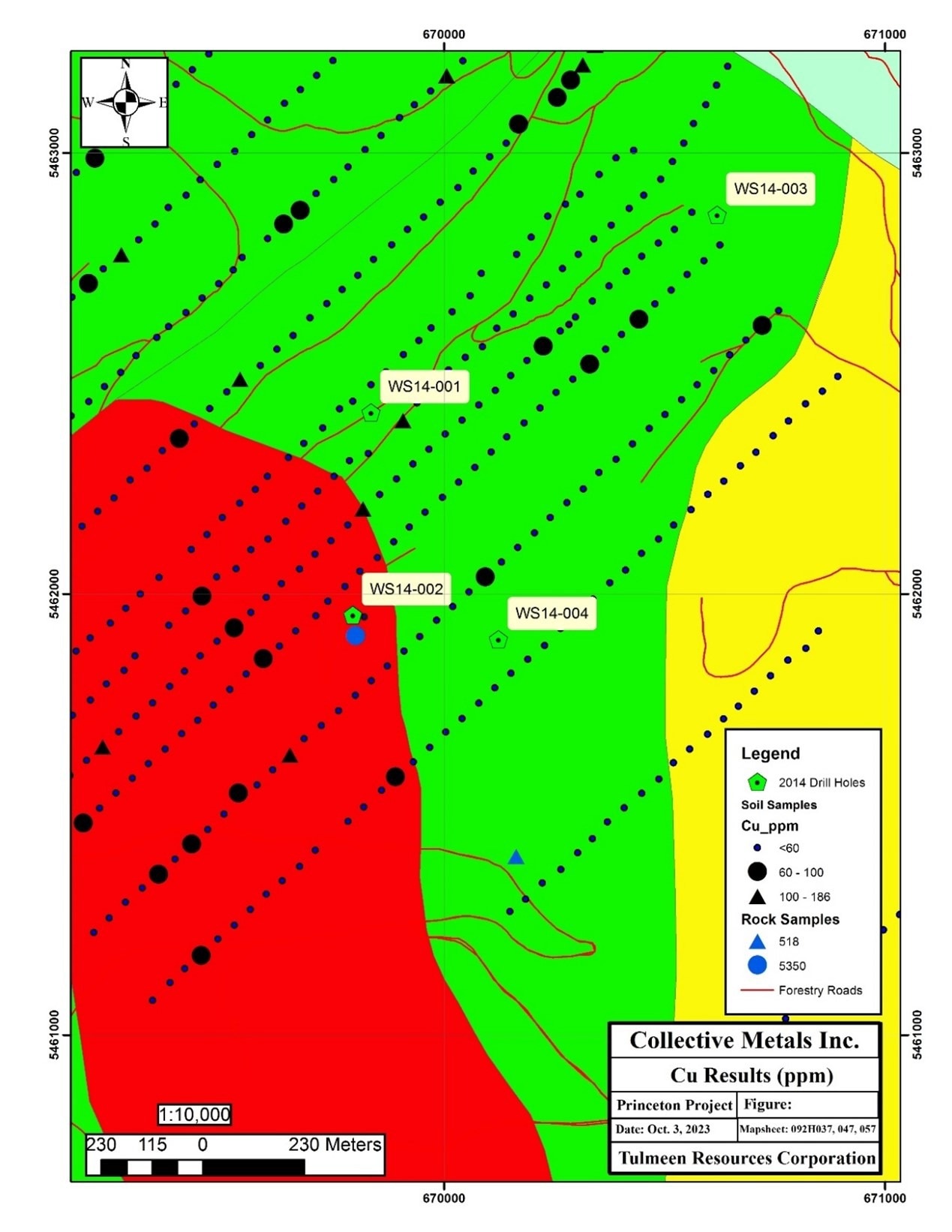Collective Metals Inc. (Company or Collective) has stated that it has obtained authorization from the former operator, Goldcliff Resource Corporation, to inspect the 2014 drill core originating from four holes drilled within the Trojan-Condor Corridor at the Company's Princeton Project (Project).

Locations of the 2014 drill collars with respect to 2023 rock and Phase I soil sample results in the Trojan-Condor Corridor in the central portion of the Project. The simplified geology of the area comprises the Eocene Princeton Group cover sequence (yellow) unconformably overlying the Late Triassic Nicola Group (green). Multiple Late Triassic diorites intrusions (red) intrude host Nicola Group rocks. Image Credit: Collective Metals Inc.
The Company's plan involves re-examining and conducting additional sampling of the available core. This core has been stored in Keremeos, British Columbia, since 2014. A preliminary site visit conducted in May 2023 confirmed that the majority of the core remains in a well-preserved condition.
The holes, ranging from 135 to 215 m in depth, were spaced quite far apart. They revealed low copper values (<953 ppm) but did show the presence of mineralized epidote-carbonate veinlets and sporadic epidote alteration in both the host Nicola Group volcanics and the intrusive diorite.
With the required permission and access granted, the Company plans to re-examine and conduct additional sampling of the drill core. Collective and the previous operator are in agreement that the holes were insufficiently deep to effectively assess the potential mineralized system due to the Eocene cover layer overlying the prospective Nicola Group.
The Company expects that additional analysis of the drill core will yield more insights from the only completed drill holes in the high-potential target region. Despite their relatively shallow nature, these holes are anticipated to offer valuable data, particularly concerning the types and scope of alteration that are present. The information expected to be derived from the re-logging comprises:
- Enhanced understanding of contact relationships between host rocks and subsequent intrusions, particularly regarding alterations.
- Identification of various alteration styles and their extent within the drill core.
- More precise sampling of mineralized intervals.
- Sampling of potential porphyry-style altered intervals, selecting samples to be included in the Porphyry Vectoring study conducted at the Mineral Deposit Research Unit at the University of British Columbia.
The Company's efforts in the 2023 field season have yielded a notably anomalous rock sample (0.535% Cu) from the Trojan area, along with multiple copper anomalies detected in soil samples. The findings from a subsequent phase II soil program are anticipated to provide additional insights into the soil anomalies within the Trojan-Condor Corridor. These results will be made available once they have been received and thoroughly reviewed.
Prior investigations have revealed several mineral showings within and in close proximity to the Trojan-Condor Corridor. These include, but are not limited to, the Trojan, Eagle, Shirley, Elk, Raven, and Nev showings, as well as numerous MINFILE occurrences. Drill targets were determined through a combination of factors, including surface rock samples with elevated values (up to 0.655% Cu, 4.8 g/t Ag, and 0.08 g/t Au), along with notably anomalous results obtained from both magnetic surveys (both airborne and ground) and an Induced Polarization (IP) survey.
The Trojan-Condor target area encompasses a substantial surface area of 2 km by 4 km, totaling 8 km², and displays several prominent chargeability anomalies. The most noteworthy of these is the Condor anomaly, which spans from the surface to a depth of at least 500 m. This interpretation suggests the presence of a deep-seated source for the anomaly and a considerable vertical extent, offering the potential for the delineation of a mineralized deposit.
We are excited to have the opportunity to further examine and re-sample the drill core from the 2014 campaign in the Trojan-Condor Corridor. We are most interested in further information regarding the styles and extent of alteration as an indication of proximity to a mineralized porphyry deposit.
Christopher Huggins, Chief Executive Officer, Collective Metals Inc.
The Company's Project offers convenient road access and is situated directly west of Highway 3 in the southern region of Princeton, BC. It resides within a mining district known for its strong infrastructure, local workforce availability, and comprehensive support services.
The Project holds the promise of discovering one or more copper-gold alkalic porphyry occurrences, akin in age and deposit type to the Copper Mountain Mine. Additionally, it is positioned approximately 10 km to the west of HudBay Minerals Inc.'s operational Copper Mountain Mine, which boasts a Proven and Probable Mineral Reserve totaling 702 million metric tons, with a copper grade of 0.24%.